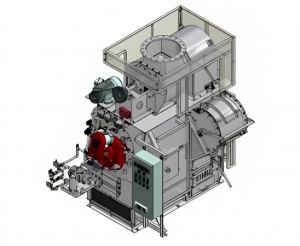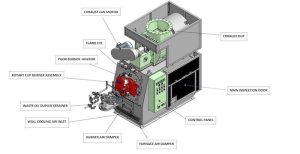A ship incinerator is an essential onboard device used to safely dispose of waste generated during maritime operations, including oily sludge, food waste, and other combustible materials. By burning waste at high temperatures, it reduces volume and minimizes environmental impact. The use of ship incinerators is governed by strict regulations under the MARPOL Convention (International Convention for the Prevention of Pollution from Ships), particularly Annex I (oily residues), Annex V (garbage disposal), and Annex VI (air pollution control).

1️⃣ What Is a Ship Incinerator?
A ship incinerator is a special equipment onboard used to burn (incinerate) certain types of ship waste safely at high temperatures to reduce volume and destroy harmful substances.
It helps keep the ship clean and protects the environment.
Why ships burn waste?
To reduce waste volume onboard
To safely destroy hazardous waste (like oily rags)
To avoid illegal overboard disposal
Burning wastes onboard is allowed only under strict IMO rules to prevent air and sea pollution.
2️⃣ Which MARPOL Annexes Control the Incinerator?
The ship incinerator is regulated by three MARPOL Annexes:
| MARPOL Annex | Related to | What it controls |
|---|---|---|
| Annex VI | Air Pollution | Rules for incinerators & emissions |
| Annex V | Garbage | What garbage can/cannot be burned |
| Annex I | Oil Pollution | Burning oily waste & sludge |
Key Connection
Ship incinerators must not pollute the air (Annex VI), must follow garbage rules (Annex V), and must burn oily waste safely (Annex I).
3️⃣ MARPOL Annex VI — Incinerator Rules
Annex VI ensures clean burning and no dangerous air pollution.
Important Annex VI Requirements
✅ Incinerator must be IMO-approved (MEPC.244(66) or later)
✅ Must have a Manufacturer Certificate of Compliance
✅ Must meet performance standards
✅ Must burn waste completely (good combustion)
✅ Must operate between 850°C and 1200°C
✅ Must NOT produce black smoke or toxic gases
✅ Must NOT burn prohibited materials
Prohibited to Incinerate (Annex VI)
❌ Polyvinyl Chloride (PVC) plastics
❌ Halons and CFC refrigerants
❌ Incineration of sewage sludge and oily sludge together (separate)
❌ No burning on open deck
❌ No burning in boilers or engines not designed for it
Unsafe burning = violation + detention + heavy fines.
4️⃣ MARPOL Annex V — Garbage Rules
Annex V controls solid board wastes.
Allowed to Incinerate
✅ Food waste (dried)
✅ Paper, cardboard
✅ Cloth, rags
✅ Wood waste
✅ Oily rags (under controlled conditions)
NOT Allowed to Incinerate (Annex V)
❌ Plastics (especially PVC)
❌ Packaging materials with toxic paint
❌ Municipal waste with chemicals
❌ Medical waste (unless approved system onboard)
5️⃣ MARPOL Annex I — Oil & Sludge Incineration
Annex I controls oily waste and engine-room sludge.
Allowed to burn:
✅ Oily rags
✅ Oil sludge from fuel treatment
✅ Waste lubricating oil
✅ Used filters (if suitable)
BUT:
⚠️ Must be fed at controlled rate
⚠️ Must ensure complete combustion
⚠️ Must NOT mix with garbage while burning
⚠️ Cannot replace Oil Discharge Monitoring Equipment (ODME) or oily-water separator rules
6️⃣ Types of Ship Incinerator Waste
| Waste Type | Source | Notes |
|---|---|---|
| Oily sludge | Fuel purifiers, drain tanks | Annex I rules |
| Oily rags | Engine room work | Must burn carefully |
| Food waste (dry) | Galley | Keep dry for efficiency |
| Paper/wood | Stores, packing | Do not overload |
| Sewage sludge | Sewage system | Burn separately from oil |
7️⃣ Typical Incinerator System Components
-
Combustion chamber
-
Burner(s)
-
Air blower (forced draft)
-
Flue gas fan / stack
-
Control panel & safety sensors
-
Temperature sensors
-
Sludge supply pump (engine room)
-
Safety shutdowns
8️⃣ Basic Operating Procedure (Cadet-Level)
🧯 Safety First
Wear PPE: gloves, goggles, coveralls, respirator if needed.
Startup Steps
1️⃣ Check waste type (ensure it’s allowed)
2️⃣ Ensure correct temperature settings (850–1200°C)
3️⃣ Open air supply dampers
4️⃣ Start blower fans
5️⃣ Start burner
6️⃣ When chamber is hot → feed waste slowly
7️⃣ Monitor:
-
Temperature
-
Ash level
-
Smoke from stack (must be clear)
-
Burner flame condition
Shutdown
1️⃣ Stop feeding waste
2️⃣ Let chamber burn down
3️⃣ Run purge fan to cool system
4️⃣ Shut burners & blowers
5️⃣ remove ash after cooling
9️⃣ Record-Keeping Requirements
Logs to record:
-
Start/stop time
-
Type of waste
-
Quantity burned
-
Temperature records
-
Problems or malfunctions
-
Officer in charge signature
Related official logbooks
| Logbook | Content |
|---|---|
| Garbage Record Book (GRB) | Solid garbage burned |
| Oil Record Book (ORB) | Oily waste & sludge burned |
| Annex VI Incinerator Log | Daily incinerator operation |
Cadets often assist in ORB & GRB entries — accuracy is critical.
🔟 Common Incinerator Problems & Prevention
| Problem | Cause | Prevention |
|---|---|---|
| Black smoke | Wet waste / poor air | Pre-dry waste, check air blower |
| Backfire | Wrong sludge pressure | Correct pump settings |
| Low temperature | Burner fault | Burner maintenance |
| Explosion risk | Flammable waste | Check waste type; remove gas cans |
| Burner trips | Low atomizing air | Check compressors & filters |
1️⃣1️⃣ Cadet Responsibilities
Cadets should:
-
Know what waste is allowed/not allowed
-
Assist in safe incinerator operation
-
Maintain cleanliness around incinerator room
-
Check temperatures & airflow
-
Record waste properly in correct logbook
-
Report unusual smell, smoke, or flame conditions
-
Follow PPE and safety checklist
Good cadets never burn prohibited materials and never fake logs.

Credit: Marineinsight
1️⃣2️⃣ Exam & Oral Test Questions
Q1: Which MARPOL Annex regulates incinerators?
✅ Annex VI + Annex V + Annex I
Q2: Can we burn plastics?
✅ No, especially PVC
Q3: Minimum incineration temperature?
✅ 850°C
Q4: Which logbooks record incineration?
✅ ORB & GRB + Annex VI incinerator log
1️⃣3️⃣ Quick Memory Tools
“P.P.P Rule” — Never Burn:
-
Plastic
-
Paint-coated waste
-
Pressurized cans
3 MARPOL Links
-
VI → Air pollution & temperature rules
-
V → Garbage burning rules
-
I → Sludge & oily waste
✅ Professional Summary
A ship incinerator must be:
-
IMO-approved
-
Operated by trained crew
-
Logged properly in ORB/GRB
-
Used only for permitted waste
-
Operated at 850–1200°C
-
Never emit black smoke or toxic gases
-
Maintained in safe condition
Improper use = pollution violation + PSC detention + environmental harm.

